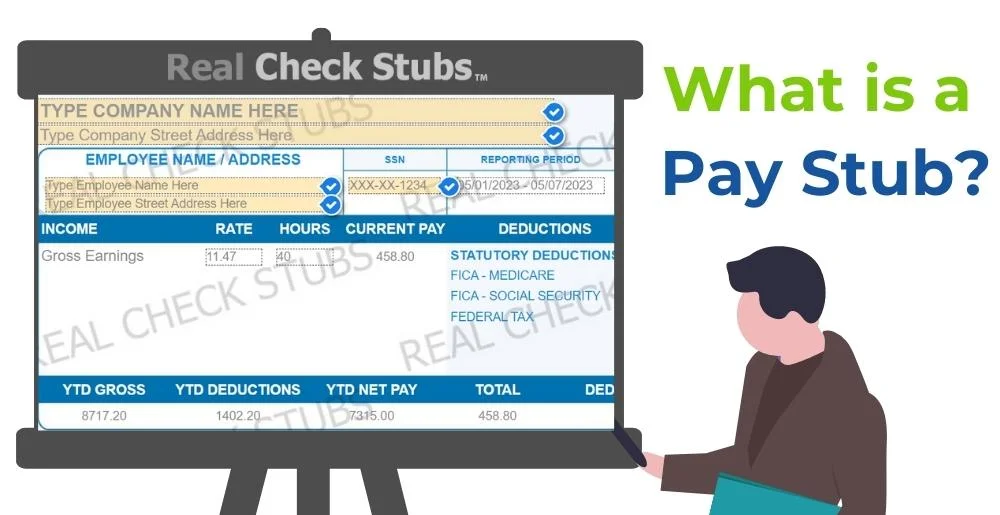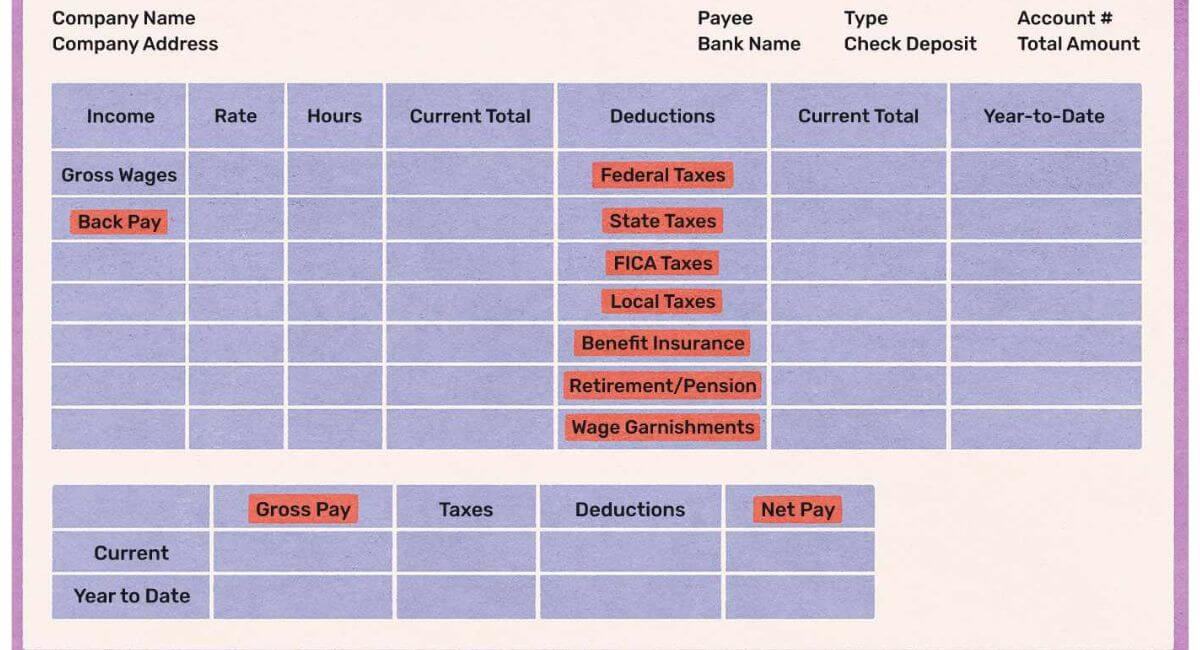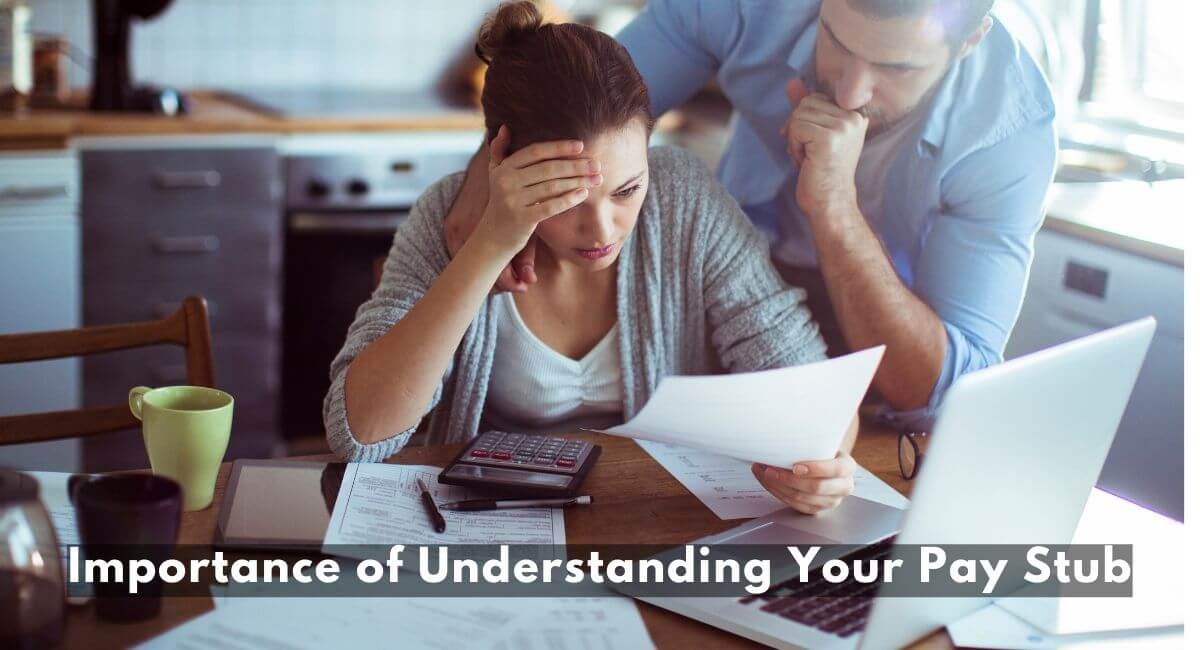What Is a Pay Stub: A Guide to Understanding Your Pay Stub
Are you having trouble understanding your pay stub? You’re not alone, as many people find the formatting of pay stubs confusing.
Reading your pay stub and being able to interpret this information is critical for ensuring you are receiving accurate payments and everyone is aware of all necessary deductions and withholdings.

Even if you’ve never been employed before, you likely have a general understanding of how wages work. However, there are a lot of nuances to take into consideration when you’re dealing with taxes, benefits, deductions, and more. To help you navigate the world of pay stubs, we’ve put together this useful guide on everything you need to know about them.
What Is a Pay Stub?
A pay stub is a document that details the earnings and deductions from an employee’s paycheck. The pay stub will show the gross amount of your earnings, the amount of any deductions that have been taken out of your paycheck, and the net amount you will receive.
Employees are usually provided a copy of their pay stub on a monthly or bi-monthly basis as necessary. The pay stub is critical for employees to understand their earnings and deductions for the following reasons:
- Make informed decisions about taxes. Pay stubs will show the amount of taxes that have been withheld from your paycheck so that you can determine if you are paying enough throughout the year.
- Avoid erroneous deductions. If you notice that your employer is withholding too much from your paycheck, you can request that the excess amount is returned to you.
- Know exactly how much you are being paid. If you have an issue with your employer about your hours, pay, or other issues relating to your pay, you can present the information listed on your pay stub to your employer to prove your case.
- Understand how your employer calculates your paycheck. It’s important to understand the deductions or other fees that may be deducted from your paycheck. The pay stub will include a breakdown of these deductibles so you can make sure you are being paid correctly.
Now that you know what a pay stub is and why it’s important, let’s take a look at how to read one.
What is included on a pay stub?

The information that is included on a pay stub can vary somewhat depending on the industry's requirements and state employment laws. Some common items that are included on pay stubs include:
- Employee name, address, Social Security number, and other information about the employee
- Employer's name and address of the business
- Pay period and date
- Hours worked
- Net wages are the funds received by an employee after all taxes and deductions have been deducted from their pay.
- Gross wages are the earnings of an employee before deductions and taxes are deducted.
- Employer contributions (FUTA, SUTA, FICA, employee benefits
- Deductions
- Taxes (federal income tax, FICA, and state and local income taxes)
- Voluntary donations, e.g. health insurance and 401K
- Direct deposit information
Types of Pay Stub Documents
Employers provide employees with several types of pay stub documents. Depending on the company, your pay stub might be delivered through an online portal or printed and sent via direct mail.
The most common type of pay stub is a standard payslip that provides details about gross wages and deductions for taxes, benefits, and other contributions. Let’s look at this and other types of employee pay stubs.
Pay Stub
A pay stub is a document that lists your earnings and deductions for a pay period, but it does not include your W-2 information. This makes it a useful tool for tracking your earnings, but it offers no information about your taxes or other deductions.
Wage and Tax Statement
A wage and tax statement is very similar to an employee's pay stub in that it lists details about your earnings and deductions. However, it also includes information about your W-2 information and taxes withheld.
W-2 Form
The W-2 form is a document your employer will issue to you at the end of the year. It is used to report your earnings and all relevant information such as taxes withheld.
1099 Form
If your employer is not a W-2 employer and you earn more than a certain amount, you may be issued a 1099 form and not a W-2. This form is similar to the W-2 in that it is used to report your earnings and all relevant information.
Deductions from Your Paycheck
Deductions are amounts that are removed from your paycheck for specific reasons. Most commonly, you may see deductions related to taxes, insurance premiums, pension plans, and retirement plans.
Employers are legally required to list all deductions on your pay stub so that you are aware of how much is being withheld. If you feel that there are erroneous deductions on your paycheck stubs, you can reach out to your employer to discuss the issue. Some deductions are mandatory, and others are voluntary.
Mandatory deductions are legally required by federal law, such as federal and state taxes. Voluntary deductions are those that you and your employer have agreed on, such as contributions to a retirement plan. Both are deducted from an employee's net pay.
Taxes Taken Out of Your Paycheck
Depending on your income and location, the government may require that you pay a certain amount of taxes each year. Taxes that your employer is responsible for withholding from your pay include federal income tax, state tax, and FICA taxes.
Federal Taxes: Federal taxes are withheld from every employee’s paycheck. The amount of taxes withheld will depend on your filing status, as well as your other income sources, such as interest and dividends.
State Taxes: Each state has its own laws regarding how much state taxes are withheld from an employee’s paycheck. You can usually select the appropriate tax rate when you fill out your W-4, and your employer will take that rate into consideration when calculating your pay.
FICA Taxes: These are taxes that are withheld from both your pay and your employer’s pay to fund Social Security and Medicare. As an employee, you will pay 6.2% of your gross earnings towards Social Security, while your employer will pay an additional 6.2%. Your employer also has to withhold 2.9% from your pay towards Medicare.
Which Deductions Are Tax-Exempt?
There are a number of deductions that are tax-exempt. So if you’re an employee, you don’t have to worry about paying taxes on them. Here is a list of deductions your employer will take from your paycheck. Please note that all deductions are subject to change as new laws are put into place.
Federal and State deductions: Federal and state taxes are withheld from your paycheck. If you live in a state that has income taxes, you can expect your paycheck to be reduced by the amount necessary to cover these taxes.
Retirement Account Deductions: If you participate in a retirement account, such as an IRA or 401(k), your employer may deduct a certain amount from each paycheck. This is to ensure that you have enough money saved to meet your retirement goals.
Health and Life Insurance Deductions: If you’re enrolled in health insurance coverage through your job, then your employer may deduct a certain amount from each paycheck. The same applies to life insurance coverage.
Understanding Your Net Pay Amount
Your net pay is the amount of money you will receive after all earned wages and mandatory deductions have been subtracted from your gross pay. Your net pay amount can be used to track your overall financial progress and gauge how you are doing, particularly when it comes to managing your expenses.
Another way to track your net pay over time is to create a pay stub template to help you organize the information. And by knowing what is included on a pay stub, you can quickly and easily understand your earnings.
Importance of Understanding Your Pay Stub

Why should you even care about your paycheck stub? Well, it’s important for a number of reasons for both the employer and employee:
First, it helps you track your earnings. One of the main purposes of your pay stub is to track your earnings and ensure everything is accurate. If you have no idea how much money you’re bringing in each month, then how will you know how much you can spend?
It also informs you of deductions. Your pay stub details your deductions and any other relevant information you need to know. If you have a child or spouse who is receiving child support, for example, you’ll need to know how much is being deducted from each of your paychecks.
Lastly, pay stub tracks your taxes and lets you know which are being withheld. With this information, you can make sure you have enough money saved to pay your taxes when they come due.
Why is it essential for an employee to look at your pay stub?
Every time an employee is paid, they must view their pay stub. This is why:
Benefits Deductions
Employees should double-check to ensure that their benefits deductions, such as health, dental, and 401(k), have been computed appropriately. Employees may not be fully registered in their benefits plan if they are not on the paystub — and may not realize it until they go to the doctor and receive a bill. Employees should double-check that coverage for children and spouses has been correctly documented.
Taxes and Withholding
One of the most essential reasons employees should verify their pay stubs is to ensure that all of the information is correct. Making certain that their name, Social Security number, pay rates, paid time off balance, and other details are all right can save you time later.
If your Social Security number is erroneous, the taxes submitted by your company to the federal and state governments will be incorrect as well. It's even feasible that your withholdings will be applied to the account of someone else.
Make sure you don't withhold too much or too little. If the figure is inaccurate, you may be in for a rude awakening come tax season. The problem with tax mistakes is that, while the amount withheld can be adjusted if there is an error, you cannot get taxes returned once they have been withheld. You must wait until tax season to file for a refund.
Paid Time Off
Employees should keep records of their vacation time throughout the year and compare it to what is on their pay stub. When paychecks arrive two weeks after time off has been taken, it is easy for employees to lose sight of their paid time off and believes they have more than they do.
Hours Worked
Even if employees are paid, it is critical that they review their hours to ensure they are right. Every pay period, hourly employees should log their hours and verify their records to the information on their pay stubs.
Why should an employer care about a pay stub?
A pay stub is helpful for tax purposes as the employer, and it may be utilized to rectify any issues with employee pay.
It gives a record of your employee's salary, assists them in understanding their taxes, contributions, and deductions, and allows them to confirm they were paid appropriately. It may also be used as proof of income or work, frequently necessary when asking for a loan, credit, or housing.
As a result, even if it is not required in your state, you may want to consider making it as simple as possible for your employees to obtain their pay stubs.
Need to Create Pay Stubs Quickly and Affordably?
With Real Check Stubs, you can create and print professional, accurate pay stubs in minutes. Our easy-to-use software allows you to quickly enter employee information and select your federal, state, and local taxes, as well as deductions and other voluntary withholdings.
No more waiting for check stubs from the payroll provider or manually creating them yourself—with Real Check Stubs, you can create accurate, up-to-date pay stubs quickly and affordably.
Kristen Larson is a payroll specialist with over 10 years of experience in the field. She received her Bachelor's degree in Business Administration from the University of Minnesota. Kristen has dedicated her career to helping organizations effectively manage their payroll processes with Real Check Stubs.

